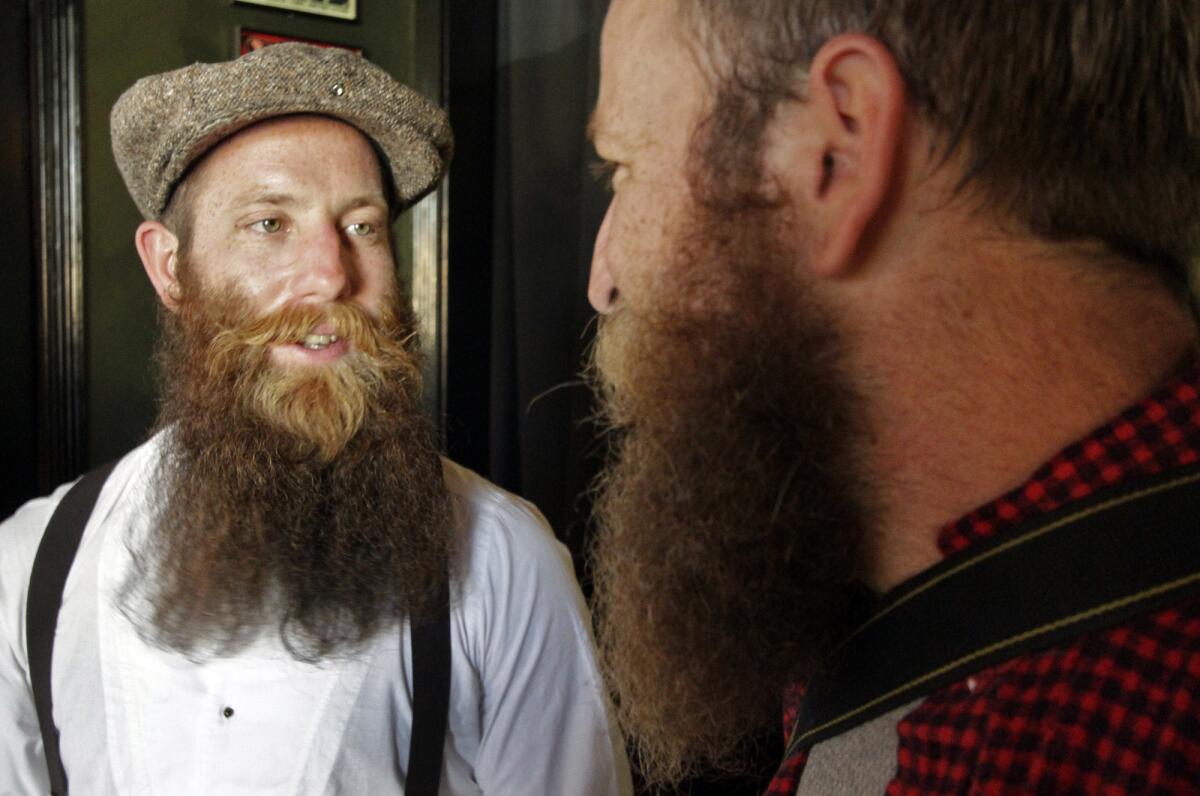Did Jesus have a beard? Why did Hitler have that strange mustache? This book explains it all.

Full Beard contestants Matt Lee, left, and Tyler Williams at the Los Angeles Beard & Mustache Competition at the Federal Bar in North Hollywood on Aug. 14, 2011.
- Share via
Have you ever wondered why Adolf Hitler had that distinctive toothbrush-style mustache? Why Martin Luther had a beard and Tarzan didn’t? Or why Jesus Christ has been depicted as both bearded and clean-shaven – sometimes in the same work of art?
Those are just a few of the tonsorial touchstones visited in “Of Beards and Men: The Revealing History of Facial Hair,” by Christopher Oldstone-Moore (The University of Chicago Press: 352pp., $30), which holds a scholarly shaving mirror up to the shifting societal acceptance of beards, from King Shulgi in the 21st century BCE through the 2013 World Series.
There’s no doubt that facial fuzz has become a part of our pop culture landscape (manscape?), thanks to the metrosexual movement, facial-hair competitions, the mustache-as-fundraising month Movember and glitter-covered hipster beards. The low point came with the 2011 “Bergholz barbers” assaults, in which attackers forcibly shaved a handful of Amish men, and the high point with the 2013 World Series -- won not as much by the Boston Red Sox but the team’s awe-inspiring collection of “rally beards.” and won the World Series. But how did we get here? That’s what Oldstone-Moore sets out to answer.
MORE: Get our best stories in your Facebook feed >>
Arranged in chapters that reflect different eras in beard history, the book covers four major beard movements: Hadrian in the second century, the Middle Ages, the Renaissance and the 19th Century. Oldstone-Moore, a senior lecturer in history at Wright State University in Dayton, Ohio, rejects biological theories for beards -- ornament to attract mates, weapon to intimidate rivals -- as inconclusive. Instead, he tackles the question from a socio-historical perspective.
He outlines three principles of beard history: 1) The face is an index of variations of manliness, 2) facial hair is political, and 3) the language of facial hair is built on the contrast of shaved and unshaved.
“Understanding the forces shaping the male face requires the long view,” he writes. “Historians who focus on one place and time may miss the larger picture that emerges over many centuries. Beard history is like a mosaic: the image becomes sharper the further back one stands.”
It’s a deep dive and the early chapters might be a bit of a scholarly slog, even for an ardent pogonophile. But, much like growing a beard itself, the investment of time and patience (not to mention the occasional recombing) can be appreciated in hindsight. We learn that ancient Sumerians and Egyptians shaved to distinguish bearded lords from clean-shaven priests, and most of the gods of ancient Greece were portrayed as beardless while mortals were bearded. The author devotes an entire chapter to explaining why Jesus was sometimes depicted with a beard and sometimes not – and it makes a lot of sense.
So too do the various political, religious, symbolic and legal ramifications that having (or not having) facial hair had over the centuries. including Religious reformer Martin Luther’s beard was “an act of anti-Catholic defiance,” Oldstone-Moore tells us: having a beard was an excommunicable offense for Catholic priests until 1917. Hitler’s minimal toothbrush mustache symbolically split the difference between being clean-shaven and sporting a style that hearkened back to past German leaders. In America, employers such as McDonald’s and Disneyland have enforced conformity by regulating beards.
Oldstone-Moore necessarily spends most of the time in the distant past – the book doesn’t really start to tonsorially tackle the 20th century until the last third – and anyone hoping for a definitive take on the current state of facial hair is likely to be disappointed, since, as the author has pointed out, the swing of the pogonic pendulum is a long one.
While there is some discussion of beards in the context of both Judaism and Islam, the only real weak spot is that “Of Beards and Men” is mostly about the beards of Western European and North American men, a fact the author himself acknowledges up front. The similarities and differences of these religious beards might merit a more in-depth discussion – especially given the tenor of current events – but Oldstone-Moore achieved what he set out to do: help the reader stand back far enough to get a good, long look at the scope of bearded history.
“Of Beards and Men” may not completely crack the code on facial hair, but once you’ve read it, it’s unlikely you’ll take any beard – or mustache – at face value again.
More to Read
Sign up for our Book Club newsletter
Get the latest news, events and more from the Los Angeles Times Book Club, and help us get L.A. reading and talking.
You may occasionally receive promotional content from the Los Angeles Times.











